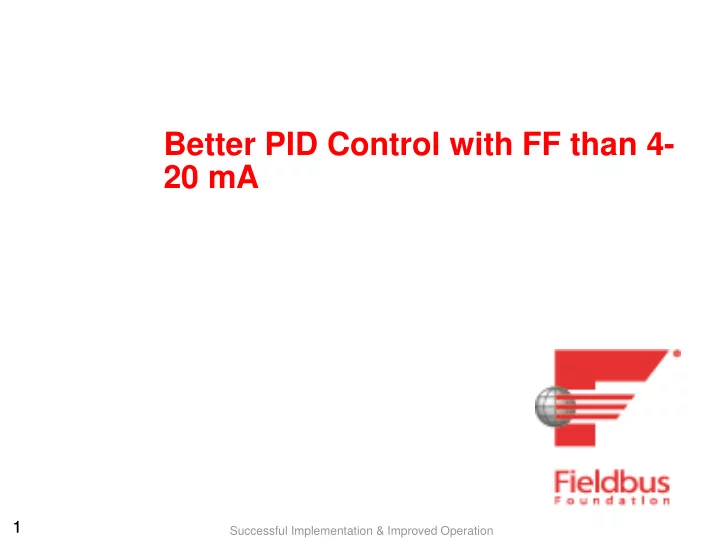

Better PID Control with FF than 4- 20 mA 1 1 Successful Implementation & Improved Operation
Video A study made by Industrial Systems and Control (ISC) in Glasgow A spin-off company from University of Strathclyde http://www.controleng.com/media-library/videos/videos/video-understanding-the-user-case-for-cif.html 2 2 Successful Implementation & Improved Operation
Summary For fast loops the performance of fieldbus control in the field is significantly better than 4-20 mA Benefits of the very highly deterministic nature of control in the field really come into its own on fast process control loops: – Pressure – Flow For pressure and flow loops the performance improved by 10-15% over a 4-20 mA loop 3 3 Successful Implementation & Improved Operation
Summary (Cont’d) For slow loop (50 second or a 1 minute) the performance benefit is less 4 4 Successful Implementation & Improved Operation
Test Results (250 ms process time) No performance difference between fieldbus and 4-20 mA loops for P and PD controllers For PI and PID fieldbus (CIF) performs better than 4-20 mA – 14.8% better for regular stepping disturbance – 29.3% better for stochastic disturbance – If the disturbance is varying slowly the improvement is less significant 5 5 Successful Implementation & Improved Operation
Test Results (10 second process time) Negligible performance difference between fieldbus and 4-20 mA loops for P and PD controllers – for slow disturbances Fieldbus improvement for PI and PID – (Most beneficial at slow controller cycle time; significant if controller is run slow to decrease load; more loops per controller) Controller Step Stochastic Scan Time Disturbance Disturbance 250 ms 6% 5.5% 500 ms 1% 8.5% 1000 ms 8% 15% 6 6 Successful Implementation & Improved Operation
Test Results (50 second process time) Fieldbus improvement for PI and PID – (Most beneficial at slow controller cycle time; significant if controller is run slow to decrease load; more loops per controller) Controller Step Stochastic Scan Time Disturbance Disturbance 250 ms 1.5% 1.5% 500 ms 2.4% 2.5% 1000 ms 4.4% 4.8% 7 7 Successful Implementation & Improved Operation
Disturbance Rejection Loops affected by fast disturbances benefit the most Slowly varying disturbance like ambient temperature sees no performance benefit There are a lot more benefits to using control in the field than just the determinism – This study just looking at the control loop performance • i.e. how much the process variability can be reduced by fieldbus 8 8 Successful Implementation & Improved Operation
Significance of the ISC Study 9 9 Successful Implementation & Improved Operation
Why Does Fieldbus Control Better than Analog? CIF is „jitter‟ free (constant sampling time) – Fieldbus devices are time synchronized – Fieldbus communication and control is scheduled – A 250 ms macrocycle is 250 ms every time 4-20 mA control loops have jitter – Because AI and AO cards are not time synchronized with the controller – AI and AO scan is independent of control – A 4-20 mA loops has: • Varying sampling time (not ideal for PID) • Longer total loop latency (input to output) Controller Control Control A A A A A A A A A A A A A A A A A A 4-20 mA Input Card I I I I I I I I I I I I I I I I I I Jitter 10 10 Successful Implementation & Improved Operation
Why is High Process Variability Bad? High process variability causes alarms – So operators shift the setpoint away from ideal to avoid these alarms (“comfort margin”) • This reduces efficiency: – Lower throughput – Higher consumption of energy and other utilities 120 120 100 100 80 80 PV 60 60 Setpoint Hi Alarm 40 40 20 20 0 0 0 5 10 15 0 5 10 15 High variability: causes alarms... ...so operators shift the setpoint 11 11 Successful Implementation & Improved Operation
Low Process Variability with Fieldbus Low process variability – Setpoint can be set closer to ideal • This increases efficiency: – Higher throughput – Lower consumption of energy and other utilities – More uniform product: greater quality/yield 120 120 100 100 80 80 PV 60 60 Setpoint Hi Alarm 40 40 20 20 0 0 0 5 10 15 0 5 10 15 High variability: causes alarms... Low variability: setpoint need not be changed 12 12 Successful Implementation & Improved Operation
Recommend
More recommend